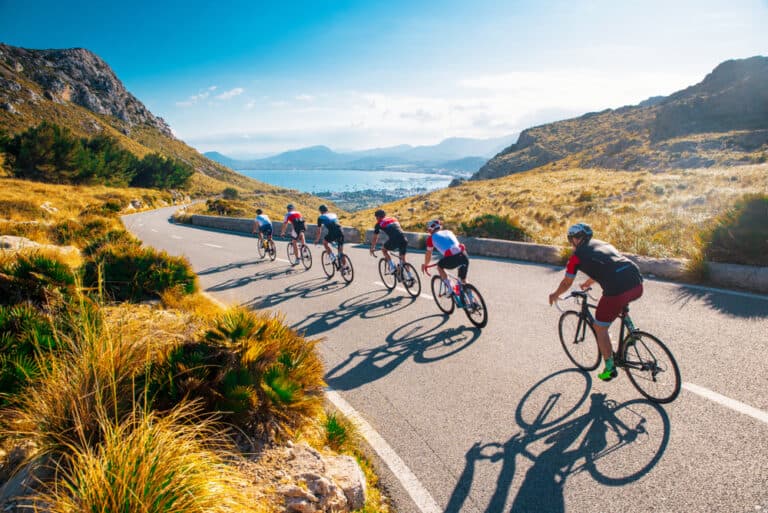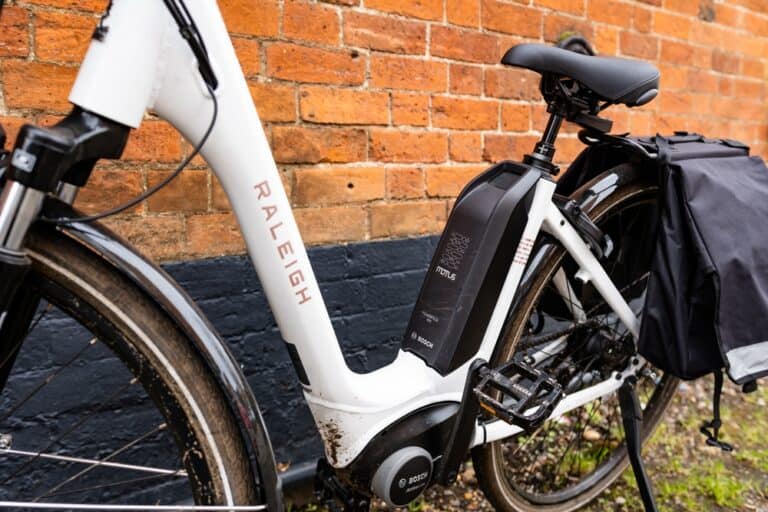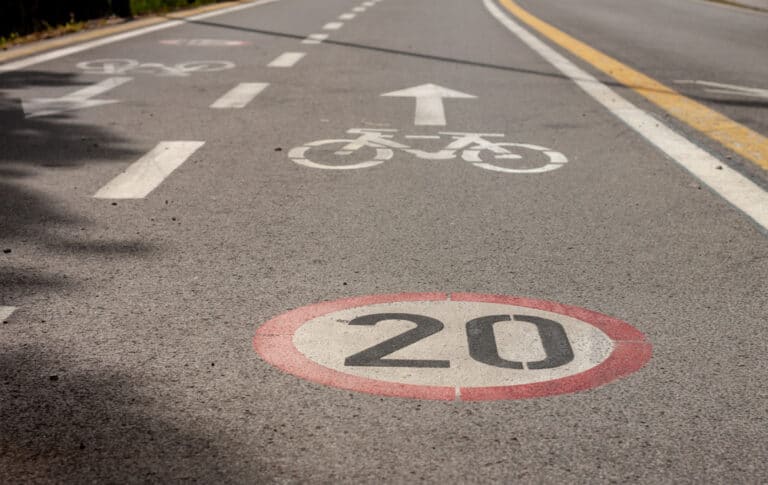Is Riding A Bike Hard?

We often hear like riding a bicycle from people who intend to describe something as being easy to do. However, how true is that statement really? I learned much later in my teens, and in truth, there are a few crucial factors that can improve the process or detract from it. So, Is riding a bike hard?
Riding a bike is not hard, although uneven terrain, steep inclines and descents, and physical or medical conditions increase the difficulty. Biking requires the rider to have a good balance and understand how to use their brakes. A bike’s seat should reach a rider’s waist for comfortability.
Riding a bike is easy enough that people use the expression like riding a bike to define an easy activity. However, people learn differently, so we’ll cover some fantastic practical tips for improving your biking skills. We’ll also cover things to watch out for that can cause you to stumble and discuss the psychological importance of using the correct learning methods.
Is Riding A Bike Hard?
Riding a bike is very much a practical learning activity, meaning no amount of hitting the books will get you to a place where you can ride comfortably. It would be best if you considered things like the bike setup and comfortability, learning to brake and balance, and whether you have physical or medical conditions.
Equip Safety Gear To Prevent Scrapes And Bruises
While you don’t want to go quite as far as fitting a strafe jacket, safety gear is vital because one nasty fall can evaporate every ounce of your motivation.
Elbow and knee pads are not strictly necessary, but a helmet must protect your head and face in case of a fall. Closed shoes are also the preferred choice to prevent your feet from hurting when you use them for balance. Lastly, you can also minimize the risk of accidents by finding a place with little traffic or people.
Prepare Your Bike For Comfortability
After you equip your safety gear, it’s time to set up your bike to make it comfortable to ride. First, ensure you can stand over your bike without the top tube hurting you. When you stand next to your upright bike, the top of the seat should reach up to your waist. Resist the urge to get the blue bike that you like so much – you wouldn’t use running shoes that were two sizes too small, right?
Proper bike fit means you have a position on the bike that lets you ride as long as you want, as hard as you want, and stay comfortable the entire time. A good fit can also help prevent overuse injuries that result from an improper position.
If you become unbearably sore while you try to ride a bike, it will dissuade you from continuing, and you might give up altogether. Of course, a bike that is too low or high will make it challenging to balance, taking you longer to learn how to ride.
A comfortable fit involves lowering the seat so you can sit on the saddle with your feet resting on the ground without bending your legs. You should also have enough reach to use the handlebars and brakes comfortably.
Get A Feel For The Brakes On Your Bike
The fear of falling can often result from not feeling comfortable in your ability to stop. Thus, do yourself a favor and familiarize yourself with the brakes on your bike; the feeling underneath your hand, the amount of strength you need to apply to squeeze the brakes, and the sweet spot for how far you need to squeeze them before they start working.
Push your bike along the street while walking alongside it, and practice pulling on the brakes to stop. Ensure you put equal pressure on both brakes. These factors are critical for increasing confidence and making your riding experience safer.
If you examine the wheels closely, you’ll see that the front rotor of your bike is bigger than the one at the back. It is intentional by design because your bike’s stopping power is in the front, not the back. If you want to stop, you should use the front brake. On the other hand, your rear brake does not provide much stopping power; it is primarily for maintaining your speed.
If you stand next to your bike, hold down the front brake and try to push the bike forward, the front suspension will sink in toward the front wheel, and the bike won’t move. In fact, you’ll notice your rear wheel will lift off the ground, indicating that all the weight is shifting to the front.
If you do the same exercise by only holding down the rear brake, you’ll see that your bicycle will slide forward. As a result, the little exercise shows you that you should rely on the front brake if you want to stop.
Remember, though, that since the front brake causes all the weight (including yours if you’re on the bike) to shift to the front, it is possible to propel yourself over the front of the bike if you go too fast and suddenly hit the front brake.
The best way to avoid going over the handlebars is to avoid speeding until you have more experience. Otherwise, you can lean back slightly before hitting the front brake to balance the bike’s weight distribution and prevent all the weight from shifting to the front.
Start Riding Your Bike To Get Some Practical Experience
The most crucial aspect that adults and kids must learn to ride a bike involves their balance, not the ability to propel themselves forward. Balance bikes, which come without pedals and allow kids’ feet to touch the ground, are renowned for teaching children how to balance on their bikes.
They are much more effective than training wheels that keep the bike upright but don’t actually teach anything. Training wheels tend to instill a false sense of confidence when it does all the work rather than letting the children learn.
When they come off, it might surprise children that they have difficulty riding, and with enough difficulty, they’ll get the impression they aren’t good enough and give up. Some parents gifted their two-year-old with a balance bike, who went on to master it in a few weeks. The same children could also ride regular bikes without training wheels at the age of three.
Thus, even as an adult, you want to start by replicating the experience of a balance bike. Remove the pedals from your bike and set the seat low enough for your feet to stand flat on the ground. As an adult, you have the advantage of the internet, so don’t be afraid to watch a couple of informative videos to help you prepare mentality. However, be careful that you don’t overthink it!
Once you remove the pedal and adjust your seat height, find a gradual sloping sidewalk or paved path. Move up and down the gradual sloping hill at your own pace while maintaining balance with your feet on the ground.
Do this several times, and when you feel comfortable enough, start lifting your feet one or three inches off the ground while trying to balance on your bike. With enough practice, you’ll have the confidence to zoom down the sloping hill without bringing your feet back to the ground! When you do this enough times, it will help you conquer your crippling fear of falling.
It’s finally time to use your bike pedals! Put the bike pedals back on your bike, and return to your previous exercise of moving up and down the sloping hill. Start by resting your feet on the pedals as you traverse downward. Once you can do this several times, take the leap of faith and start pedaling on even ground.

What Would Make Learning To Ride More Difficult?
When learning to ride a bike, certain exterior elements can slow the learning process or bring it to a complete stop. Suppose you have a severe case of basophobia, the fear of falling, physical limitations or you exceed the recommended weight limit. In that case, it will affect your ability to learn how to ride a bike.
Basophobia
Basophobia is a natural fear of falling that affects most humans and animals to varying degrees. It is distinct from acrophobia (fear of heights) but closely related. Instead of the heights themselves, the fear of falling involves the concerns that accompany the feeling and the potentially harmful implications of falling.
It might sound cliché, but the best way to conquer a fear is to do it to prove to your mind that the truth is not equivalent to your own reality. Practically, learning balance with a balance bike is a great way to teach that to your mind. Naturally, your body will follow and be more willing to try and ride a bike.
Physical Or Medical Hindrances
Physical disabilities or conditions that weaken your grip can make applying the required brake strength more challenging. Be wary of any visual impairment because the inability to steer and avoid obstacles might make the learning process more stressful, especially for children. Similarly, if you exceed the recommended weight limit for the bike, it might not be easy to learn proper balance.
Learning to ride a bike might be harmful if you have a medical condition like osteoporosis. It causes bones to become brittle, so much so that even small actions like leaning over or coughing can cause a fracture. Most osteoporosis-related fractures are common in the spine, hip, or wrist.
Bone is a living tissue that continually breaks down and builds up again. Osteoporosis results from the formation of new bone that does not keep up with the loss of old bone. Medications, eating healthily, and weight-bearing exercise can help prevent bone loss or strengthen bones that are already weak.
Your Reasons For Wanting To Learn Should Be Clear
While you should listen to your body and adhere to physical or medical conditions, your intention or reason for learning to ride a bike is one of the most critical steps of the process.
Your reasons will motivate you to learn so that you can ride with your children or grandkids orenjoy cycling as a new hobby and lose weight. Take a look at the world around you – if people want something enough, they’ll do whatever it takes to get it – it’s part of our drive for survival as humans.
Record your reasons and intentions on a piece of paper (it’s important that you write it and not type it) and put it on the wall to remind you and help you envision yourself at the end and the joy it will bring you.
Drop Bars Are Not Suitable For Beginners
When you start learning to ride a bike, avoid using bikes with drop bars – the kind that looks like rams’ horns. These handlebars are not suitable for new riders because they require a particular type of posture that might make them feel uncomfortable.
Furthermore, their purpose is to reduce wind resistance and improve the maximum speed of the bike – something only applicable if you plan to race or commute great distances.
Instead, opt for flat handlebars because they allow the rider to assume an upright posture and also make it a little easier to brake.
Is It Dangerous To Learn To Ride A Bike?
Other than medical issues that might preclude being on a bicycle safely, riding a bike is not any more dangerous than any other than walking. They are much slower than a car and have a severely limited capacity to cause injury to others.
If you plan to commute, you should learn the road rules to ensure you stay safe while cycling between pedestrians and vehicles.
According to the vehicle code of many states in the US, bicycles do not identify as vehicles because they don’t have motorized engines. Interestingly, some states’ vehicle codes, like Philadelphia, extend to bicycles, meaning getting a DUI while riding a bike is possible.
Conclusion
Riding a bike is not hard when you employ the right learning methods. Start by prioritizing balance by removing your bike pedals, and once you have enough confidence, put them back. Consider any physical or mental issues that hinder you, so you don’t overdo it. Lastly, remember your reason for wanting to learn because it will motivate you to push through the complex parts.
Sources
- https://www.quora.com/Is-it-difficult-to-learn-how-to-ride-a-bicycle
- https://www.bicycling.com/skills-tips/a20026575/how-to-learn-to-ride-a-bike-as-an-adult/
- https://www.reddit.com/r/cycling/comments/8wdtwm/im_trying_to_learn_how_to_ride_a_bike_i_would/
- https://www.reddit.com/r/cycling/comments/8lcz6m/i_seriously_underestimated_how_hard_this_would_be/
- https://www.reddit.com/r/cycling/comments/a7rkma/how_easy_is_it_to_learn_how_to_ride_a_bike/
- https://www.bicycling.com/skills-tips/a20036352/bike-fit-0/
- https://www.youtube.com/watch?v=t_QwZGxYRy4
- https://en.wikipedia.org/wiki/Fear_of_falling
- https://www.mayoclinic.org/diseases-conditions/osteoporosis/symptoms-causes/syc-20351968







